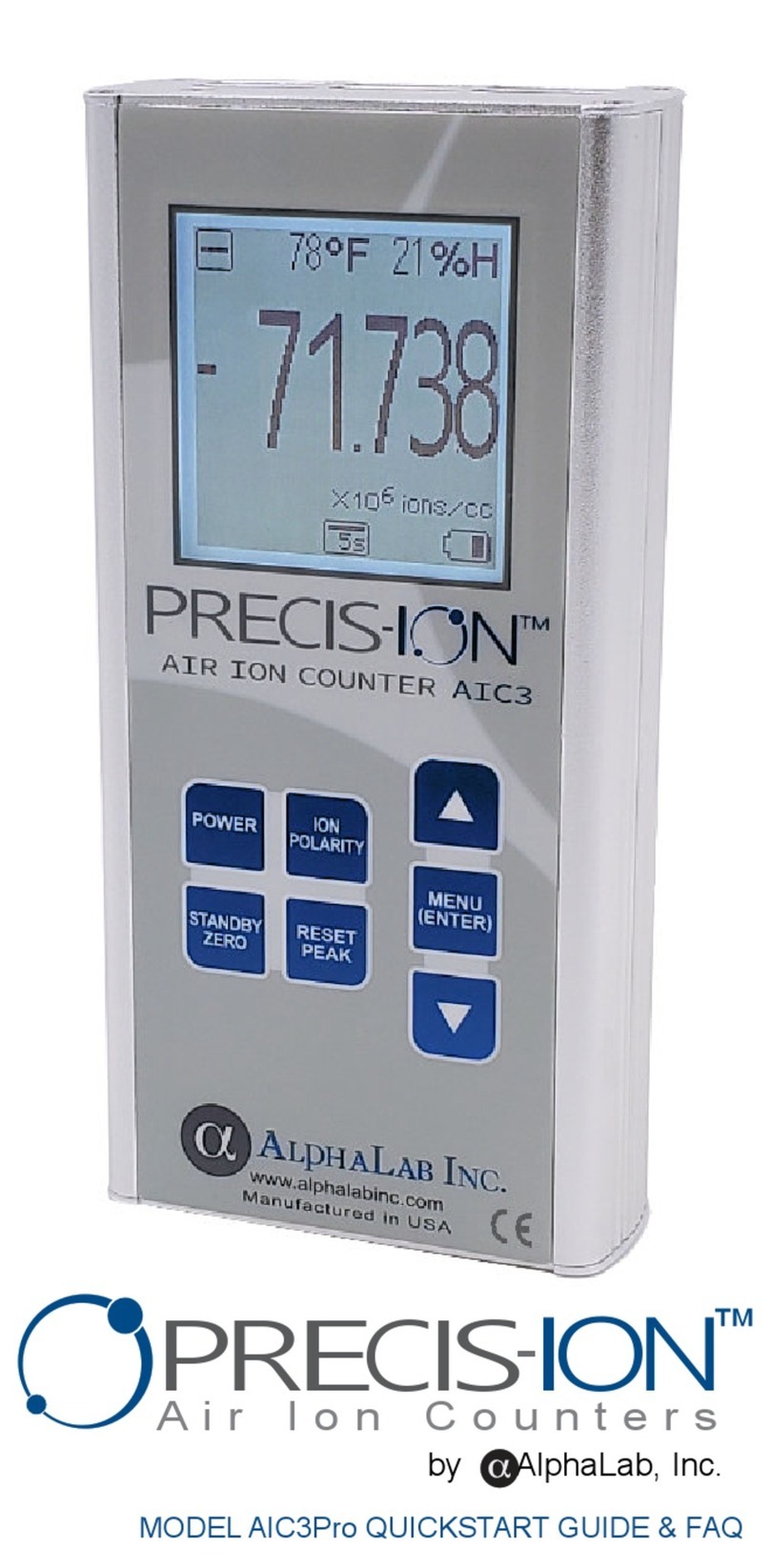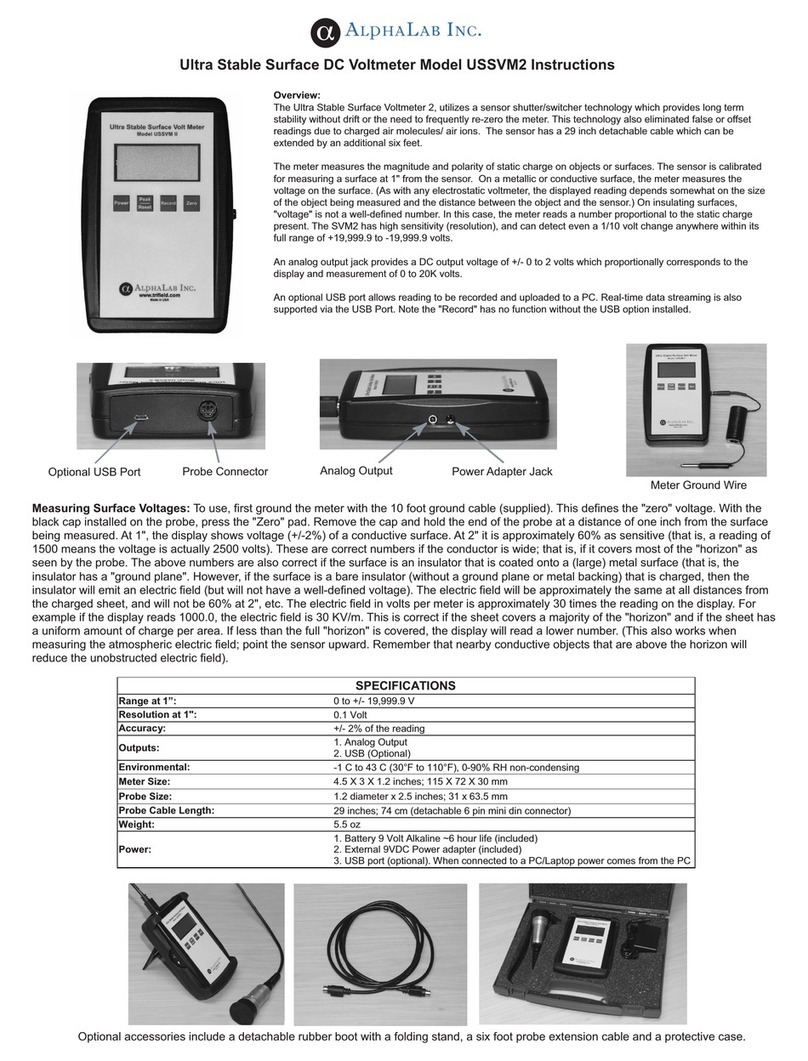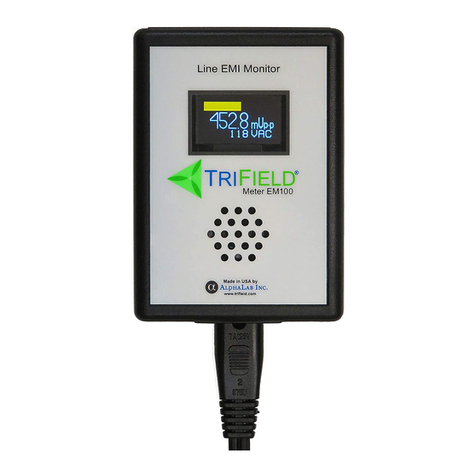
This magnetometer (gaussmeter) measures DC magnetic field (with polarity) up to + or
Operation:
Turn the meter on by pressing “Power” for at least 1 second Note that the last few millimeters at the (black) end of the
probe has a square bulge on one side; the other side is flat
from the tip The brass is on the “flat” side
The center of that square bulge is the location of the Hall
is very small (0 2 x 0 2 mm)
Place the flat side of the probe’s end (not the square bulge side) against the surface to be
measured A ne
gative sign indicates that the probe is touching the south pole of a magnetized object; in contrast, a north
pole will read positive (“positive” is indicated by the
sensor is 1 1mm above
the flat surface or 1 0mm below the top of the square bulge) and is centered in the center of the
square bulge
Below 10 gauss, only three digits (such as “
stronger than +/-
799 99 gauss, the extreme left digit will display
about one hour of battery life remaining
Remove the soft bumper or “boot” if present, and then slide off the battery door
on the back side Replace with a common 9
be removed by holding the meter so that the battery can fall out, and then tapping the meter on a table
7ma and the LO BATT reads if bat
tery voltage remains below 7V for at least one minute
battery voltage of 5 8V) You may need to press “Power” twice the first time with a new battery MAKE SURE THE
METER TURNS ON AFTER REPLACING THE BATTERY
Offset
Adjustment (only necessary if measuring weak fields):
The offset controls
allow you to add or subtract
you are holding the sensor in a certain orientation in space, and you want
field is present
Press “Auto Zero” to do this
equivalent of adjusting the “tare” weight of a weight scale, because there may be an a
want to subtract out When turned on
, the display will read approximately zero in zero field, but you can more precisely
adjust the offset to zero if you do one of two things, either:
1)
Place the sensor in a “zero
gauss chamber” (not supplied with this meter, but see www trifield com) and
Zero
2)
Place the sensor end flat on a non-
magnetic table or desk with the square bulge facing up
will read the upward-pointi
ng component of the magnetic field
should then read a negative number )
Note the number on the display
down This 2
nd
reading should be the
should be 0 40 (gauss)
If the two readings are not the negative of each other, then the
a zero reading in zero field For example
gauss (the average of the two readings)
of opposite sign Offset is adjusted by pres
HS Instructions
This magnetometer (gaussmeter) measures DC magnetic field (with polarity) up to + or
Turn the meter on by pressing “Power” for at least 1 second Note that the last few millimeters at the (black) end of the
probe has a square bulge on one side; the other side is flat
Note also that a small section of brass is visible about 15mm
The center of that square bulge is the location of the Hall
Place the flat side of the probe’s end (not the square bulge side) against the surface to be
gative sign indicates that the probe is touching the south pole of a magnetized object; in contrast, a north
pole will read positive (“positive” is indicated by the
absence of a polarity sign on the display)
the flat surface or 1 0mm below the top of the square bulge) and is centered in the center of the
0 37”) will be displayed
For stronger fields, more digits will appear
799 99 gauss, the extreme left digit will display
(It is a “1”)
If the display reads “LO BATT”, there is
Remove the soft bumper or “boot” if present, and then slide off the battery door
volt rectangular battery Alkaline is preferred
The old battery can most easily
be removed by holding the meter so that the battery can fall out, and then tapping the meter on a table
tery voltage remains below 7V for at least one minute
(Accuracy errors will occur below
battery voltage of 5 8V) You may need to press “Power” twice the first time with a new battery MAKE SURE THE
METER TURNS ON AFTER REPLACING THE BATTERY
Adjustment (only necessary if measuring weak fields):
allow you to add or subtract
any field
to or from the displayed number of gauss
you are holding the sensor in a certain orientation in space, and you want
the display to show “zero”, even though some
Press “Auto Zero” to do this
Then you can bring in a magnetized object to measure
equivalent of adjusting the “tare” weight of a weight scale, because there may be an a
mbient magnetic field that you’ll
, the display will read approximately zero in zero field, but you can more precisely
adjust the offset to zero if you do one of two things, either:
gauss chamber” (not supplied with this meter, but see www trifield com) and
magnetic table or desk with the square bulge facing up
In this orientation, the meter
ng component of the magnetic field
(If the field is instead downward-
pointing there, the meter
Note the number on the display
Then flip the sensor so the square bulge is facing
of the 1
st
reading That is, if the 1
st
reading was –
If the two readings are not the negative of each other, then the
offset
is not adjusted perfectly for
st
reading is 1 00, and the 2
nd
reading is 0 00, then the
offset knob so that the 1
st
and 2
nd
readings are the same number but
-
” buttons If you hold one button down, the offset amount will
This magnetometer (gaussmeter) measures DC magnetic field (with polarity) up to + or
- 799 99 gauss
Turn the meter on by pressing “Power” for at least 1 second Note that the last few millimeters at the (black) end of the
Note also that a small section of brass is visible about 15mm
The center of that square bulge is the location of the Hall
-Effect sensor, which
Place the flat side of the probe’s end (not the square bulge side) against the surface to be
gative sign indicates that the probe is touching the south pole of a magnetized object; in contrast, a north
the flat surface or 1 0mm below the top of the square bulge) and is centered in the center of the
For stronger fields, more digits will appear
For fields
If the display reads “LO BATT”, there is
Remove the soft bumper or “boot” if present, and then slide off the battery door
The old battery can most easily
be removed by holding the meter so that the battery can fall out, and then tapping the meter on a table
Current drain is
(Accuracy errors will occur below
battery voltage of 5 8V) You may need to press “Power” twice the first time with a new battery MAKE SURE THE
to or from the displayed number of gauss
This feature is used if
the display to show “zero”, even though some
Then you can bring in a magnetized object to measure
This is the magnetic
mbient magnetic field that you’ll
, the display will read approximately zero in zero field, but you can more precisely
gauss chamber” (not supplied with this meter, but see www trifield com) and
then press Auto
In this orientation, the meter
pointing there, the meter
Then flip the sensor so the square bulge is facing
nd
is not adjusted perfectly for
reading is 0 00, then the
offset is off by 0 50
readings are the same number but
” buttons If you hold one button down, the offset amount will























